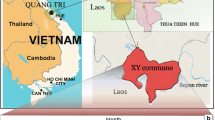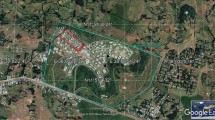Abstract
Water imbalances remain the primary problem from the past to the coming future in karst area of South China. A well-admissive method to cope with drought and flood problems is under searching. Rainwater harvesting by water tanks has being an approved way to alleviate water shortage, but with some defects such as bad water quality, unstable sources, and limited volume. To find out its running status, 50 water tanks in a part region of Fengshan County were surveyed. One of them was chosen for online-monitoring and 25 water tanks were sampled for chemical analysis. The results show that there were three typical problems during its running. First, water tanks usually get dry in rainless months, especially in extremely drought events. Second, water quality declines once water has stored for about 100 days with no new supplement. The deterioration of water quality is related to the long-preserved time rather than exogenetic pollution. Third, the situation becomes more serious under the pressure of climate change and the rocky desertification. Therefore, a new rainwater harvesting strategy is proposed for improving this situation. The conception site model (CSM) in hill slope for tank location selection is the critical point, since water harvesting for tanks depends on slope characters. As a CSM example, the hillslope hydrology related to the overland flow, the resurgence of flow in epikarst, and vadose flow at Yaji Karst Experiment Site were investigated to illuminate the complexity of hydrological process and diversity of flow pattern. Then, it is suggested to make full use of different flows from slopes, especially to increase the availability of vadose flow. Finally, besides drinking purpose, water tanks should be extensively used for irrigation and reforestation to obtain economic return and support its maintenance.






Similar content being viewed by others
References
Akter A, Ahmed S (2015) Potentiality of rainwater harvesting for an urban community in Bangladesh. J Hydrol 528:84–93
An kJ, Lam YF, Hao S, Morakinyo TE, Furumai H (2015) Multi-purpose rainwater harvesting for water resource recovery and the cooling effect. Water Res 86:116–121
Campisano A, Modica C (2012) Optimal sizing of storage tanks for domestic rainwater harvesting in Sicily. Resour Conserv Recycl 63:9–16
Cao JH, Yuan DX et al (2005) Karst ecosystem of Southwest China constrained by geological setting. Geological Publishing House, Beijing
Gunn J (1981) E Hydrological processes in karst depressions. Zeitschrift für Geomorphologie NF 25(3):313–331 (Zeitschrift für Geomophologies, Schweizerbart’s Sche Verlagsbuchhandlung, Science Publishers)
Guo F, Jiang GH (2008) Present state and protection of water quality of water cellar in karst mountain areas of South China: a case study on Mumei subterranean stream basin. Water Resour Prot 21(1):18–20
Guo F, Jiang GH, Yuan DX, Polk JS (2013) Evolution of major environmental geological problems in karst area of southwestern China. Environ Geol 69:2427–2435
Guo XJ, Jiang GH, Gong XP, Yin JJ, Wu X (2015) Recharge processes on typical karst slopes implied by isotopic and hydrochemical indexes in Xiaoyan Cave, Guilin, China. J Hydrol 530:612–622
Gwenzi W, Dunjana N, Pisa C, Tauro T, Nyamadzawo G (2015) Water quality and public health risks associated with roof rainwater harvesting systems for potable supply: review and perspectives. Sustain Water Qual Ecol 6:107–118
Huang RH, Liu Y, Wang L, Wang L (2012) Analysis of the causes of severe drought occurring in Southwest China from the Fall of 2009 to the Spring of 2010. Chin J Atmos Sci (in Chinese) 36(3):443–457
Jiang ZC, Lian YQ, Qin XQ (2014) Rocky desertification in Southwest China: impacts, causes, and restoration. Earth Sci Rev 132:1–12
Jiang GH, Guo F, Polk JS, Kang ZQ, Wu JC (2015) Delineating vulnerability of karst aquifers using hydrochemical tracers in southwestern China. Environ Earth Sci 74:1015–1027
Karim MR, Bashar MZI, Imteaz MA (2015) Reliability and economic analysis of urban rainwater harvesting in a megacity in Bangladesh. Resour Conserv Recycl 104:61–67
Liu MX, Xu XL, Sun AY, Wang K (2014) Is southwestern China experiencing more frequent precipitation extremes? Environ Res Lett 9:064002
Liu BJ, Chen CL, Lian YQ, Chen JF, Chen XH (2015) Long term change of wet and dry climatic condition in the southwest karst area of China. Global Planet Change 127:1–11
Long D, Shen YJ, Sun A, Hong Y, Longuevergne L, Yang YT, Li B, Chen L (2014) Drought and flood monitoring for a large karst plateau in Southwest China using extended GRACE data. Remote Sens Environ 155:145–160
Lu YR (2007) Karst water resources and geo-ecology in typical regions of China. Environ Geol 51:695–699
Wang LC, Lee DW, Zuo P, Zhou YK, Xu YP (2004) Karst environment and eco-poverty in Southwestern China: a case study of Guizhou province. Chin Geol Sci 14(1):21–27
WHC, World Heritage Convention (2015). http://whc.unesco.org/en/list/1248/. Accessed 28 June 2018
Xu K, Yang DW, Xu XY, Lei HM (2015) Copula based drought frequency analysis considering the spatio-temporal variability in Southwest China. J Hydrol 527:630–640
Yao YB, Zhang Q, Wang JS, Shang JL, Yang Y, Shi J, Han LY, Li Y (2014) The response of drought to climate warming in Southwest China. Ecol Environ Sci (in Chinese) 23(9):1409–1417
Yuan DX (ed) (2014) Regional problems on environmental geology in South and Southwest China and their count measurement (in Chinese). Science Press, Beijing
Yuan DX, Cai GH (1988) Karst environment in China. Chongqing Press, Chongqing
Yuan DX, Drogue C, Dai AD, Lao WK, Cai WT, Bidaux P, Razack M (1990) Hydrology of the karst aquifer at the experimental site of Guilin in Southern China. J Hydrol 115:285–296
Acknowledgements
Financial support was provided by Chinese National Natural Science Foundation (41472239, 41772269), Chinese Academy of Geological Sciences (YYWF201504), and Guangxi Hydraulic Research Institute.
Author information
Authors and Affiliations
Corresponding author
Rights and permissions
About this article
Cite this article
Jiang, G., Guo, F., Lo, K.F.A. et al. Utilization status of rainwater harvesting and its improvement techniques in bare karst areas for domestic use and ecological restoration. Carbonates Evaporites 34, 1381–1390 (2019). https://doi.org/10.1007/s13146-018-0459-5
Accepted:
Published:
Issue Date:
DOI: https://doi.org/10.1007/s13146-018-0459-5




